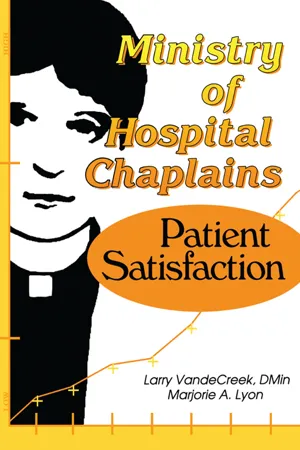
- 76 pages
- English
- ePUB (mobile friendly)
- Available on iOS & Android
About This Book
Evaluating the success of hospital chaplaincy has been a difficult task, but finally an effective approach has been developed. Ministry of Hospital Chaplains: Patient Satisfaction presents the Patient Satisfaction Instrument for Pastoral Care (PSI) which measures the quality and character of spiritual care and can contribute to the establishment of professional norms. To find out whether specific changes in pastoral practices lead to increased satisfaction among patients, this test can be used periodically. As you will see, this allows managers and department heads to identify and monitor specific functions and areas in which improvement is needed.Ministry of Hospital Chaplains will help you analyze the background variables that are associated with patient satisfaction, the styles of pastoral care that are linked to better hospital outcomes, and the usefulness of different pastoral activities. In the end, you will be able to use empirical evidence to demonstrate to hospital administrators that patients appreciate pastoral care and that chaplains are helping patients recuperate, experience an easier time at the hospital, and get home more quickly. Besides discussing how to evaluate the effectiveness of chaplains, this insightful book explores:
- enacting continuous improvement efforts
- pastoral care characteristics that predict a patient's readiness to return home
- how attention to details can build protocols that respond to patients
- questionnaire responses from 2, 000 discharged hospital patients in the U.S. and Canada
- why the need to evaluate the benefits of pastoral care exists
- the aspects of pastoral care most important to patientsChaplains in general and those in psychiatric hospitals, hospital administrators, managed care directors, and seminary professors of pastoral care will be glad to know that a technique for evaluating pastoral services has finally arrived. The guessing game is over. Now, you will know what your patients think of the services your hospital offers, and you can measure alternative approaches to pastoral care delivery when discontent is registered.
Frequently asked questions
Information
Item% | Mean | SD | |
Totals for the Positive Subscales (1, 2 & 4) | 3.53 | .70 | |
Totals for the Negative Subscale (3... |
Table of contents
- Cover
- Half Title
- Title Page
- Copyright Page
- CONTENTS
- ABOUT THE AUTHORS
- Preface
- Introduction
- A Perspective on Patient Satisfaction
- Background on the Patient Satisfaction Instrument and the Current Data Bank
- How Can the Results Be Maximized?
- Patient Satisfaction with the Ministry of Hospital Chaplains
- Characteristics of Pastoral Care That Contribute to Better Patient Outcomes (from the Patients’ Viewpoint)
- What Have We Learned?
- So What? Implications for Hospital Pastoral Care
- How Can You Use the PSI?
- Appendix: Weighted Mean Scores
- Index